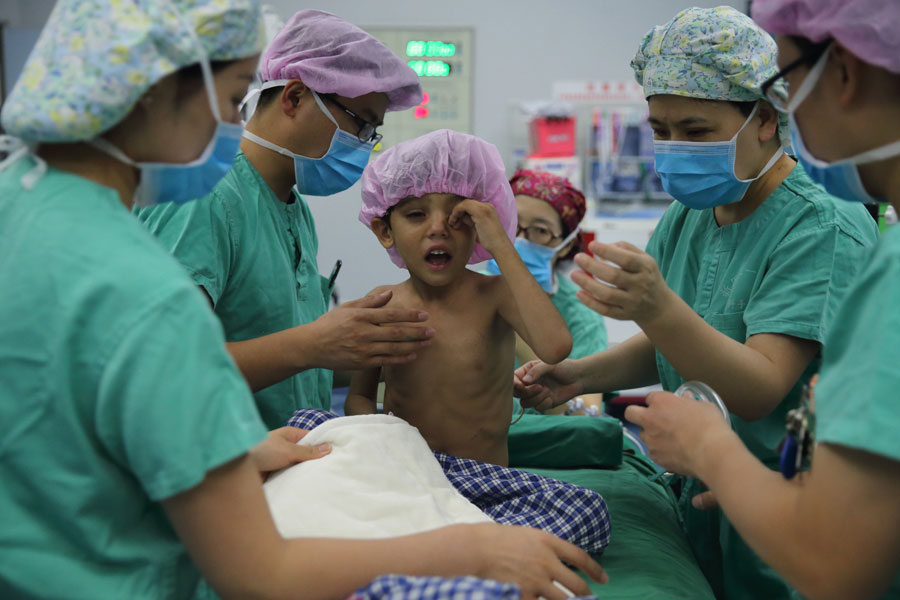Red Cross offers Afghan children a lifeline
Doctors in northwestern China have performed lifesaving surgeries on 17 Afghan children with congenital heart disease, the first of many expected to receive help through an ongoing Red Cross program.
A child with congenital heart disease from Afghanistan is prepared for an operation at the First Affiliated Hospital of Xinjiang Medical University in northwestern China on Saturday. The program is part of the Red Cross Society of China's humanitarian activities in countries involved in the Belt and Road Initiative. [Photo/China Daily] |
It comes after a Chinese medical team visited Kabul, the capital of Afghanistan, late last month to prepare desperately ill youngsters to be flown to China for free advanced treatment.
The first group of 21 children, aged 2 to 14, arrived at the First Affiliated Hospital of Xinjiang Medical University on Aug 30. As of Monday, 17 had undergone successful operations and were recovering well, according to Zhang Haibo, head surgeon for the program.
"The first day of operations (on Friday) all went well," he said. "Doctors from across China have become a great team in the operating room."
Angiza, 2, was among four children who received surgery on Friday. It took seven doctors three hours to fix an atrial septal defect, a serious condition that can affect oxygen levels in the blood.
Other children, like Marwa, have been receiving nonsurgical treatment. The 3-year-old has an abnormal heart structure, which means she is weaker and thinner than an average child of her age. Due to complications, doctors decided that surgery was too risky.
After being screened by Chinese medics at the Kabul Royal Hospital, the first group of 21 children, aged 2 to 14, arrived at the First Affiliated Hospital of Xinjiang Joma Gull, the child's grandfather, has accompanied her on the trip to Urumqi, capital of the Xinjiang Uygur autonomous region, which borders Afghanistan.
"I heard about the program about two weeks ago, so I took her to Kabul from my hometown to see the Chinese doctors," he said. "I trust the highly skilled doctors will help Marwa become healthy and have a normal life."
The children and their guardians were expected to stay at the hospital for 15 days, during which staff members will help them to relax in their new environment.
The Red Cross Society of China, which runs the humanitarian program, has said it aims to initially help about 100 children. Meanwhile, the Red Crescent Society of Afghanistan estimates nearly 7,000 Afghan children with congenital heart disease are in urgent need of treatment.
Doctors from Shanghai, Beijing and Xinjiang arrived at Kabul Royal Hospital to start screening children for the program on Aug 26.
To get there, they traveled in armored vehicles, as suicide bombings and kidnappings are still a threat in the city. However, personal safety was not their major concern.
"Our goal was to bring the children to China for surgery as soon as possible. Anything else was less important," said Sun Shuopeng, secretary-general of the Chinese Red Cross Foundation, the fundraising arm of the society, who led the foreign aid team.
Originally, the doctors planned to screen only children age 7 and under. Yet as the demand among older children was so high, they decided to expand the program to those aged 8 to 14.
"Although some of the children's heart defects are not difficult to fix, they have missed the best time for treatment-which was when they are younger-due to the poor medical conditions in Afghanistan. So there are risks," said surgeon Zhang, who is director of Shanghai Children's Medical Center's cardiothoracic department.
The program is backed by the Belt and Road Fraternity Fund, which the Chinese Red Cross Foundation launched in February to support humanitarian activities and cooperation in countries involved in the Belt and Road Initiative.
The fund, mostly made up of donations from Chinese corporations, has become a new channel for domestic enterprises to perform humanitarian work, according to Wang Ping, the society's vice-president.
Military conflicts, natural disasters and uneven socioeconomic development are common in countries and regions along the proposed Silk Road Economic Belt and the 21st Century Maritime Silk Road, which means local demand for humanitarian aid is immense, he said.
Using the fund, the foundation established an emergency care center at Pakistan's Gwadar Port in May in cooperation with its local counterpart, the Pakistan Red Crescent Society.
As China's largest humanitarian group, the Red Cross Society is a major platform for boosting people-to-people diplomacy, as it can rally nongovernmental resources as well as boost communication and cooperation at the individual level, Wang said. It is also more likely to be well received by local communities, he added.
As the first 21 children recover from vital treatment and get ready to return to Afghanistan, another group is preparing to head to China.
"We will give the children the best gift they could ever wish for-a new life," Sun said.
